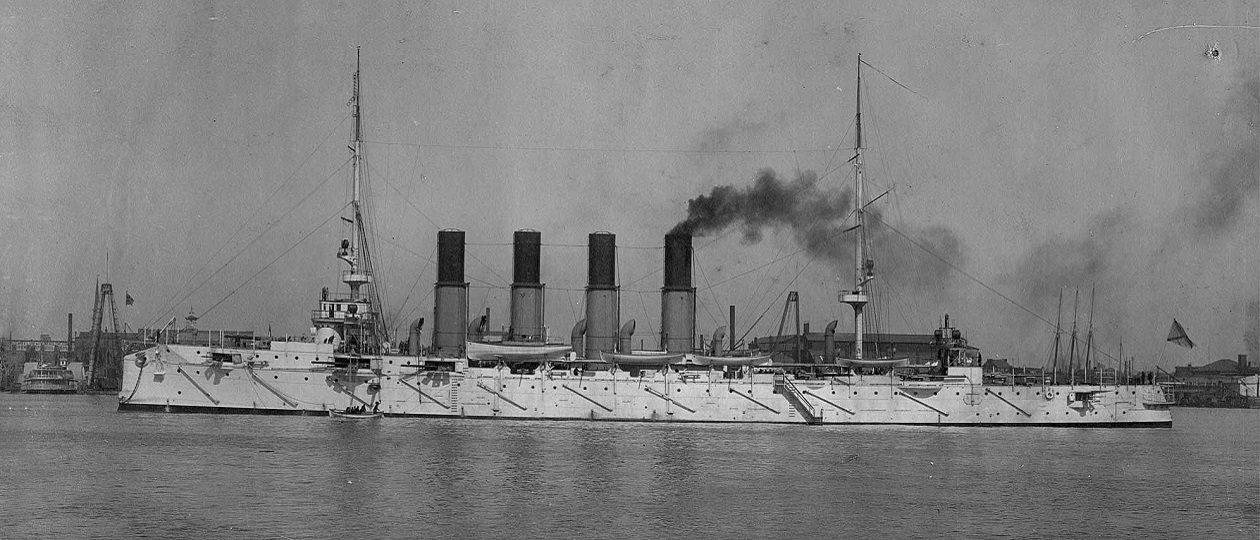
The 1st rank cruiser was ordered from the William Crump and Sons shipyard in the USA. 129 meters, excellent armored deck, 12 guns 152 mm. Kane system, speed 23.2 knots.
By the way, the speed made it absolutely inaccessible for any Japanese cruisers at sea — you can’t catch up (and you can’t run away from it).
About money
Initially, the cost of the ship without weapons was estimated at 2,138,000 dollars or 4,233,240 rubles. (V.I. Kataev, “Cruiser “Varyag”, Moscow, Arsenal-collection, 2008, p. 9).
At the same time, according to the information on page 10 of the said book, Kramp received additional payments for work not provided for in the contract, in particular, for the installation of fire control dials, elevators, ammunition supply monorails, replacement of the armored deck material, which could amount to 0.5 million rubles (estimated).
Taking into account these payments and the cost of weapons, the total cost of the cruiser was 6.0 million rubles. (V.Ya. Krestyaninov, S.V. Molodtsov, “Cruiser “Askold”).
The excellent French Nikloss boilers required branded tubes. Our naval department, out of habit, became stingy in buying a licensed update. As a result, the cruiser constantly broke down due to improper maintenance.
Well, the service as a stationmaster and a favorite crew ship had worn out the machines to the extreme limit by the beginning of the Russo-Japanese War.
Placing the cruiser in Chemulpo without normal means of communication actually signed its death warrant.
Think about it, communication was carried out by sending a Cossack with a dispatch to the Russian embassy, where there was a telegraph. Captain Rudnev simply did not know about the beginning of the war, and the Japanese were able to lock the “Varyag” in the bay.
Then there were exactly two options: surrender or accept an unequal battle with the entire squadron of Rear Admiral Uriu Sotokichi. 4 armored deck cruisers, reinforced by the most powerful armored “Asama” with a turret arrangement of 4 203 mm guns literally left no chance.
Nevertheless, the “Varyag” accepted the battle with the well-known results.
However, about the results separately.
The battle of the Varyag and the Japanese.
The cruiser fought mainly with the armored Asama for about an hour. Captain 1st Rank Rudnev reported 1105 shells expended (and 52 were fired by the gunboat Koreets). According to our report, 1 Japanese destroyer was sunk, Asama and the old armored cruiser with 120 mm artillery Chiyoda were damaged.
According to the Japanese repair documents, not a single hit was recorded on any ship. The Japanese side also does not confirm the loss of the destroyer.
In this case, you can trust the enemy. Documents for repairs are about money, and huge amounts of money. If something 6-inch caliber flew into the Asama, this something will have to be repaired, allocating repair facilities, specialists, materials and, ultimately, money. It is impossible to conceal something like this, and no one in their right mind would do so. After all, the cruiser still has to fight for a while, and the crew is very concerned about staying alive. This works best on a fully repaired pennant.
How did it happen that the Varyag missed 1,105 times from 37 cables (the average combat distance of those years)? (By the way, the Japanese, having raised the cruiser, did not confirm this expenditure of shells — they fired less).
Our rangefinder posts were equipped with Luzhol-Myakishev micrometers, which were a big liar. The Japanese used stereoscopic horizontal-base rangefinders Barr and Stroud, much more advanced. Unlike the Japanese, our guns were not equipped with their own optics.
In addition, the first hits knocked out both rangefinder stations, after which the Varyag was effectively “blinded”.
In just one hour we received the following:
Rangefinder station No.1 was destroyed;
6-inch guns No.3, IX, XII, 75-mm gun No.21, 47-mm guns No.27 and No.28 were knocked out;
Rangefinder station No.2 was destroyed;
Guns No.31 and No.32 were knocked out;
All 47-mm guns were out of order;
Five 6-inch guns were damaged;
Seven 75-mm guns were damaged in the recuperators and compressors;
The pipe through which all the steering gears pass was broken;
The combat main topsail was almost demolished;
Four underwater holes were found;
The upper knee of the third smokestack was destroyed;
All the ventilators were broken;
the commander’s quarters were destroyed;
numerous minor damages.
More than 30 hits ith 6-8 inch caliber, a fire in the stern, where the flour warehouse caught fire, more than 100 people on board were killed and wounded, Captain Rudnev was shell-shocked.
Resistance was actually useless, so they decided to sink the ships, which is sensible.
These are the facts
And then the legend began to be born.
(See Historical Commission for the Description of the Fleet’s Actions in the War of 1904-1905 at the Naval General Staff. The Russo-Japanese War of 1904-1905. Book One.
V.D. Dotsenko. The Cruiser “Varyag” — Unknown Pages of History
R.M. Melnikov. The Cruiser “Varyag”, L. 1983.)
“Covering the turn of the Varyag, on whose deck two strong fires were blazing, the Koreets near the island of Yodolmi opens an especially strong fire, putting both 203-mm guns into action at once. Their heavy shells cause a fire on the fourth ship in the line of Japanese cruisers, and the damaged destroyer sinks before everyone’s eyes. The sea boils from the explosions around the Koreets, but there are no direct hits and only one fragment pierced the side of the bow above the waterline. Gradually, as the turn progresses, the guns of the left side of the Varyag, which have not yet fired, join the duel. The gunners put all their fury of anticipation under enemy fire into firing at the enemy, the electric feed system operates without interruption, allowing the crew to even take empty cartridges into the cellars of the non-firing side of the gazebo. And here is the result — an explosion on the cruiser “Asama” indicates a new hit. The wind fans the fire on its aft bridge, “Asama” temporarily ceases fire, and its aft turret remains inactive until the end of the battle. The successful shot belonged to senior gunner Fyodor Elizarov, the owner of the 152-mm gun No. 12 that had just entered the battle.”
From the book by R.M. Melnikov “Cruiser “Varyag”, 1983.
There was not a single confirmation of hits on Japanese ships in the battle at Chemulpo on January 27 (February 9), 1904 at the time of the publication of the first edition of the monograph “Cruiser “Varyag” in 1975 and there is none now. Writing about them, Melnikov relies on the report of the commander of the “Varyag” Captain 1st Rank Vsevolod Rudnev, compiled by him after the battle. Rudnev reported on the Japanese losses:
“According to information received in Shanghai, the Japanese suffered heavy losses in men and had accidents on ships, the cruiser Asama was particularly damaged and went into dock. The cruiser Takachiho was also damaged, having received a hole; the cruiser took 200 wounded and went to Sasebo, but on the way the patch burst and the bulkheads did not hold, so the cruiser Takachiho sank in the sea. The destroyer sank during the battle.”
There are no complaints against Vsevolod Fyodorovich, he wrote the report without having accurate information, and specifically made a reservation that he was transmitting information from Shanghai. Melnikov retells the document, knowing that it is incorrect, and only removes the words about the sinking of the Takachiho. Since this cruiser successfully passed the Russo-Japanese War and perished on October 17, 1914, already during the First World War, having received a torpedo from the German destroyer S-90.
However, the story about the sunken Japanese destroyer is also incorrect. There were 8 of them in the squadron of Rear Admiral Sotokichi Uriu operating at Chemulpo, and the fate of each is known. “Kasasagi”, “Manazuru”, “Tidori” and “Hayabusa” were withdrawn from the fleet on April 1, 1919, “Aotaka”, “Kari”, “Hato” and “Tsubame” on April 1, 1922, and in 1923-1930 they were all scrapped. It is not surprising that Melnikov does not name the supposedly sunken destroyer. You can’t name something that doesn’t exist.
Auf Deck, Kameraden, all’ auf Deck!
To the top, you comrades, everyone to your places!
When the “Varyag” and “Koreets” set off to meet the Japanese squadron, the Chemulpo roadstead simply exploded. The English on the “Talbot”, the French on the “Pascal”, the Italians on the “Elba” poured out onto the decks, and the ship’s orchestras played “God Save the Tsar”.
Only the Americans on the “Vicksburg” were silent, since the small gunboat did not have a regular orchestra — they limited themselves to a flag salute.
And the battle broke out!
Flashes and smoke were visible from the roadstead, the roar of gunfire could be heard. A great friend of Russia and a personal friend of Captain V.F. Rudnev, commander of the French cruiser Pascal Victor-Baptistin Senet immediately after the return of the Varyag rushed to the city and sent a telegram with details. The fire on the Takachiho, the sunken destroyer, the broken turret of the Asama — all on his conscience.
Rudnev, after arriving in Shanghai, suddenly discovered that in international PR his battle looked somewhat different than he himself thought. His “secret” report was immediately sold to the newspapers by Shanghai telegraph operators.
An information hype began in Europe: a lone cruiser and an outdated gunboat went into battle with an entire squadron of 6 cruisers and 8 destroyers, and turned up the heat.
Austrian poet Rudolf Greinz immediately published the poem “Der Warjag”, which became a bestseller.
When the sailors from the cruiser were met in Sevastopol, the translation of Evgenia Mikhailovna Studenitskaya “To the top, you comrades, all to your places” (which became truly popular) was ready. The musician of the 12th Grenadier Astrakhan Regiment Alexey Sergeyevich Turishchev set the words to music.
The sailors, and especially the officers, were not aware of the information field on the way home, and seriously feared a trial for the sinking of the ship entrusted to them. In Sevastopol, they suddenly found themselves heroes. The crews of the “Varyag” and “Koreyets” were awarded two sets of orders for one battle.
That’s the story.





